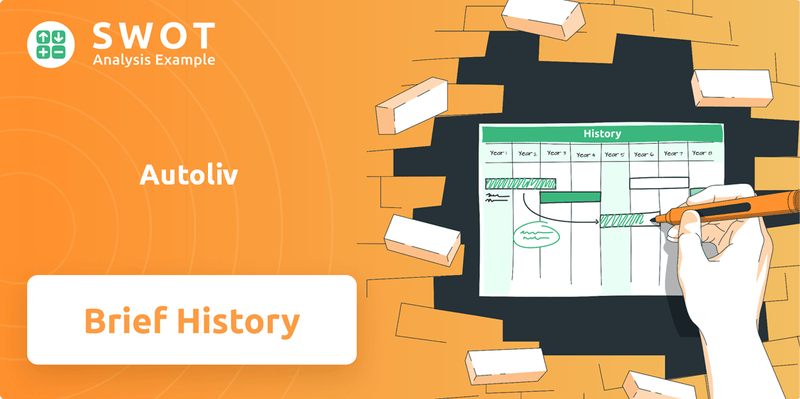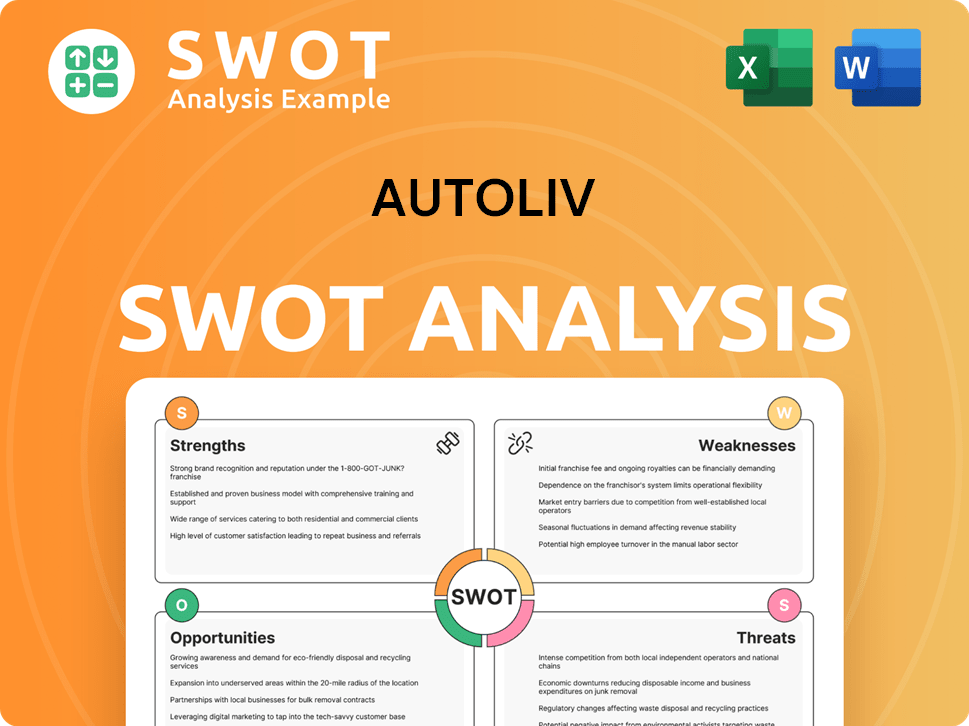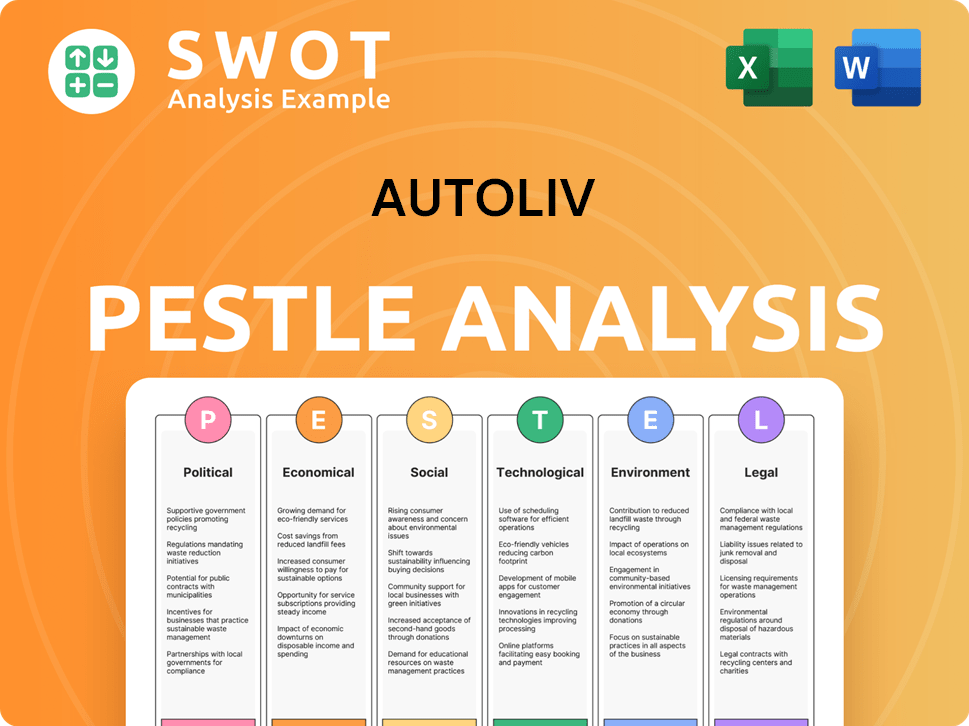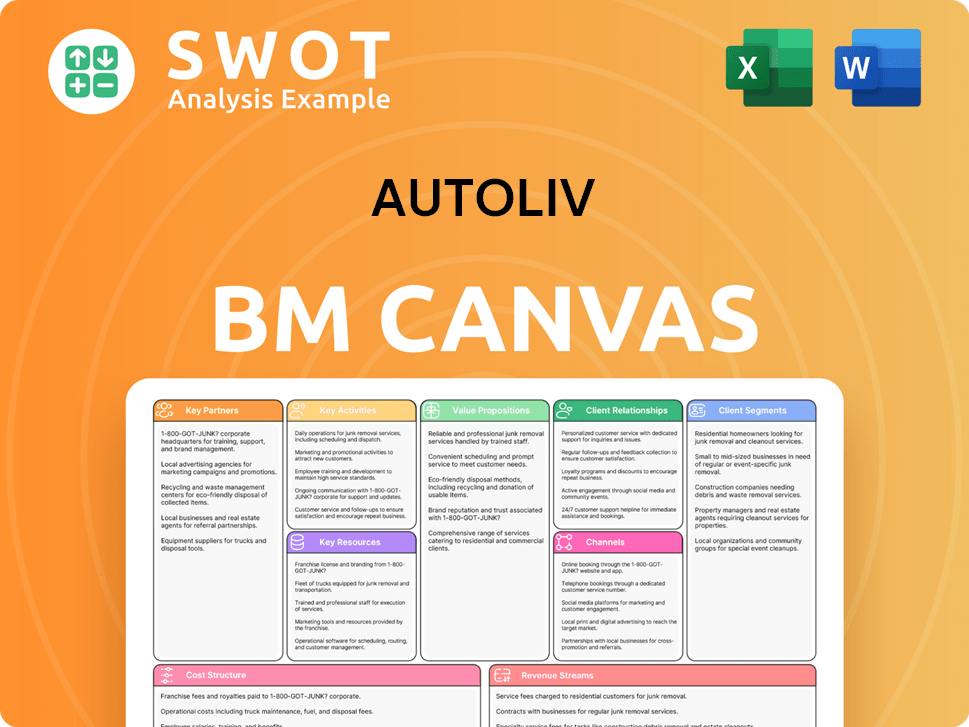Autoliv Bundle
How did a small Swedish seatbelt maker become a global automotive safety giant?
Born from a commitment to protect lives, Autoliv's story is a compelling journey through the evolution of car safety. From its humble beginnings in 1953, the Autoliv SWOT Analysis reveals a strategic approach to innovation and expansion. This article delves into the pivotal moments that transformed Autoliv from a seatbelt manufacturer into a leading force in automotive safety systems.

Autoliv's history is a testament to the power of innovation in the automotive industry. Understanding the Autoliv company timeline provides valuable insights into the advancements in automotive safety and car safety. This exploration of Autoliv, from its early innovations to its current suite of Autoliv products, offers a comprehensive view of its impact on road safety worldwide.
What is the Autoliv Founding Story?
The story of Autoliv begins in 1953 in Vårgårda, Sweden. The company was established with the primary goal of manufacturing seatbelts. This marked the start of a journey focused on improving automotive safety.
The initial focus was on developing and producing seatbelts. This was a direct response to the growing awareness of road safety issues in the mid-20th century. The company's founders saw an opportunity to commercialize and improve restraint systems, which were becoming essential in automobiles.
The business model centered on supplying these critical safety components directly to automotive manufacturers. Early funding likely came from local investments. The initial product offering was seatbelts, representing a significant advancement in passive safety technology. The rising vehicle ownership and traffic accidents in the 1950s drove demand for effective safety solutions. Autoliv aimed to meet this demand from its inception.
Autoliv's early years were focused on seatbelt production, addressing the growing need for car safety. The company quickly established itself as a key player in the automotive safety sector.
- The company’s foundation was laid in 1953 in Vårgårda, Sweden.
- Autoliv's early product was focused on seatbelts.
- The company's early business model involved supplying seatbelts to automotive manufacturers.
- The focus on automotive safety was driven by increasing vehicle ownership and rising traffic accidents.
Autoliv's commitment to innovation and safety has made it a key player in the automotive industry. For a deeper understanding of its position, you can explore the Competitors Landscape of Autoliv.
Autoliv SWOT Analysis
- Complete SWOT Breakdown
- Fully Customizable
- Editable in Excel & Word
- Professional Formatting
- Investor-Ready Format

What Drove the Early Growth of Autoliv?
The early growth of the Autoliv company was marked by its focus on automotive safety. Founded in 1953, the company quickly established itself as a key supplier of seatbelts. A significant step was the introduction of the first seatbelt reminder in 1966, highlighting its commitment to safety innovation. Autoliv expanded its product range to include more advanced features as automotive technology evolved.
A pivotal moment was the 1997 merger with Electrolux's safety division, forming Autoliv Inc. This broadened its offerings to include airbags, making it a comprehensive passive safety systems supplier. This strategic move allowed entry into new markets and securing contracts with global manufacturers.
Continuous investment in research and development led to advancements in airbag technology, including side and curtain airbags. Autoliv focused on scaling manufacturing and establishing a global footprint to meet increasing demand for advanced safety features. This growth phase saw a strategic shift towards becoming a full-system supplier.
Autoliv's global presence expanded significantly. By the early 2000s, the company had established manufacturing facilities and technical centers across North America, Europe, and Asia. This global presence was crucial for serving the needs of international automotive manufacturers.
In 2023, Autoliv reported net sales of approximately $9.2 billion. The company's focus on innovation and strategic acquisitions helped maintain its position as a leading supplier of automotive safety systems. Autoliv's commitment to R&D has consistently accounted for a significant portion of its revenue, around 6% in recent years.
Autoliv PESTLE Analysis
- Covers All 6 PESTLE Categories
- No Research Needed – Save Hours of Work
- Built by Experts, Trusted by Consultants
- Instant Download, Ready to Use
- 100% Editable, Fully Customizable

What are the key Milestones in Autoliv history?
The Autoliv history is marked by significant achievements and a continuous drive to advance automotive safety. From its early days to its current standing, Autoliv has consistently expanded its capabilities and global footprint, becoming a key player in the car safety industry.
| Year | Milestone |
|---|---|
| 1953 | Autoliv was founded in Sweden, initially focusing on safety belts. |
| 1970s | Autoliv expanded its product range to include airbags and other safety systems. |
| 1997 | Autoliv merged with the safety division of Electrolux, significantly broadening its product portfolio and market reach. |
| 2000s | The company continued to grow globally, establishing a strong presence in major automotive manufacturing regions. |
| 2010s | Autoliv focused on innovations for autonomous driving and electric vehicles, expanding its product range. |
| 2024 | Autoliv continues to be a leading supplier of automotive safety systems, with a focus on advanced safety technologies. |
Autoliv has been at the forefront of innovation in automotive safety, consistently introducing new technologies to enhance car safety. The company's research and development efforts have led to numerous breakthroughs, including advanced airbag systems and pedestrian protection features.
Autoliv pioneered the development of various airbag systems, including frontal, side, and curtain airbags, improving occupant safety in collisions. These innovations have become standard features in modern vehicles, significantly reducing injuries and fatalities.
Autoliv has continuously improved seatbelt technology, integrating pre-tensioners and load limiters to enhance occupant protection. These advancements work with airbags to provide comprehensive safety solutions.
The company has developed advanced driver-assistance systems (ADAS), including automatic emergency braking and lane-keeping assist. These systems aim to prevent accidents before they occur.
Autoliv has invested in sensor technologies, such as radar and cameras, to enhance the performance of safety systems. These sensors provide critical data for ADAS and other safety features.
Autoliv has developed systems to mitigate injuries to pedestrians in the event of a collision. These systems include pedestrian airbags and other protective measures.
Autoliv is developing safety solutions for autonomous vehicles, including advanced sensors and software. These technologies are essential for ensuring the safety of self-driving cars.
Despite its successes, Autoliv, like other companies in the car safety industry, faces several challenges. The automotive industry is highly competitive, with constant pressure to reduce costs and improve efficiency.
Autoliv competes with other major automotive suppliers, requiring continuous innovation and cost optimization. This competitive landscape demands that Autoliv remains agile and responsive to market changes.
The automotive industry is cyclical, and economic downturns can impact Autoliv's financial performance. The company must manage its operations to withstand economic volatility.
Stringent safety regulations and standards require Autoliv to continuously invest in research and development. Compliance with these regulations is critical for maintaining market access.
The transition to electric vehicles and autonomous driving presents both opportunities and challenges. Autoliv must adapt its products and strategies to meet the demands of these emerging technologies.
Global supply chain issues can affect the availability of components and materials, impacting production. Autoliv must manage its supply chain effectively to minimize disruptions.
Automakers continuously seek cost reductions, requiring Autoliv to optimize its manufacturing processes and supply chain. Balancing cost efficiency with product quality is crucial.
Autoliv Business Model Canvas
- Complete 9-Block Business Model Canvas
- Effortlessly Communicate Your Business Strategy
- Investor-Ready BMC Format
- 100% Editable and Customizable
- Clear and Structured Layout

What is the Timeline of Key Events for Autoliv?
The Autoliv company has a rich history, marked by significant advancements in automotive safety. Founded in Vårgårda, Sweden, the company began with seatbelt production and has evolved into a global leader in car safety systems. Over the years, Autoliv has expanded its product range, integrating airbags and active safety technologies. The company has adapted to industry changes, including supply chain disruptions and the rise of electric vehicles, while consistently focusing on innovation and occupant protection. Autoliv continues to develop advanced safety solutions and remains dedicated to its mission of saving lives.
| Year | Key Event |
|---|---|
| 1953 | Autoliv was founded in Vårgårda, Sweden, initially focusing on the production of seatbelts. |
| 1966 | Autoliv introduced the first seatbelt reminder, enhancing safety features. |
| 1997 | Autoliv merged with Electrolux's safety division, creating Autoliv Inc., and expanding its product portfolio to include airbags. |
| 2000s | Autoliv continued to develop and expand its airbag and seatbelt technologies, including side and curtain airbags. |
| 2010s | The company increased its focus on active safety systems, integrating radar, camera, and night vision technologies. |
| 2018 | Autoliv spun off its electronics business, Veoneer, to concentrate solely on passive safety systems. |
| 2020-2023 | Autoliv navigated supply chain disruptions and semiconductor shortages, impacting the automotive industry. |
| 2024 | Autoliv continued to invest in next-generation passive safety solutions and optimize its manufacturing footprint. |
Autoliv is expected to maintain its leadership in passive safety, focusing on enhancing existing technologies and developing new solutions for future vehicle architectures. The company's strategy centers on adapting to the evolving automotive landscape, particularly in autonomous driving and electric vehicles. Autoliv aims to integrate passive and active safety systems for comprehensive occupant protection. Analyst predictions support continued demand for Autoliv's products, driven by global safety regulations and consumer awareness.
Autoliv's strategic focus includes enhancing core passive safety solutions, such as advanced airbags and seatbelts that adapt to varying occupant positions. The company is leveraging its expertise to integrate passive safety more seamlessly with active safety systems. This holistic approach to occupant protection is designed to meet the demands of future mobility. The company is committed to innovation, operational efficiency, and sustainable practices.
As of Q1 2024, Autoliv reported net sales of $2.5 billion, reflecting a strong market presence. The company anticipates full-year 2024 organic sales growth of around 5%. This financial performance underscores Autoliv's strong position in the automotive safety market. Autoliv's financial outlook and strategic investments are aligned with its founding vision of saving lives and preventing injuries.
Autoliv's research and development efforts are focused on creating next-generation safety systems. The company is working on more advanced airbags and seatbelts that can adapt to different crash scenarios. These innovations are crucial for enhancing occupant protection in both traditional and autonomous vehicles. Autoliv's commitment to technological advancement ensures its continued relevance and leadership in automotive safety.
Autoliv Porter's Five Forces Analysis
- Covers All 5 Competitive Forces in Detail
- Structured for Consultants, Students, and Founders
- 100% Editable in Microsoft Word & Excel
- Instant Digital Download – Use Immediately
- Compatible with Mac & PC – Fully Unlocked

Related Blogs
- What is Competitive Landscape of Autoliv Company?
- What is Growth Strategy and Future Prospects of Autoliv Company?
- How Does Autoliv Company Work?
- What is Sales and Marketing Strategy of Autoliv Company?
- What is Brief History of Autoliv Company?
- Who Owns Autoliv Company?
- What is Customer Demographics and Target Market of Autoliv Company?
Disclaimer
All information, articles, and product details provided on this website are for general informational and educational purposes only. We do not claim any ownership over, nor do we intend to infringe upon, any trademarks, copyrights, logos, brand names, or other intellectual property mentioned or depicted on this site. Such intellectual property remains the property of its respective owners, and any references here are made solely for identification or informational purposes, without implying any affiliation, endorsement, or partnership.
We make no representations or warranties, express or implied, regarding the accuracy, completeness, or suitability of any content or products presented. Nothing on this website should be construed as legal, tax, investment, financial, medical, or other professional advice. In addition, no part of this site—including articles or product references—constitutes a solicitation, recommendation, endorsement, advertisement, or offer to buy or sell any securities, franchises, or other financial instruments, particularly in jurisdictions where such activity would be unlawful.
All content is of a general nature and may not address the specific circumstances of any individual or entity. It is not a substitute for professional advice or services. Any actions you take based on the information provided here are strictly at your own risk. You accept full responsibility for any decisions or outcomes arising from your use of this website and agree to release us from any liability in connection with your use of, or reliance upon, the content or products found herein.